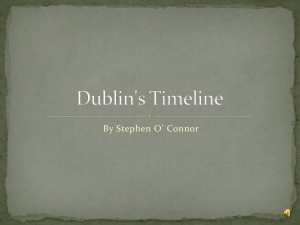Ten years Medieval Dublin review
advertisement
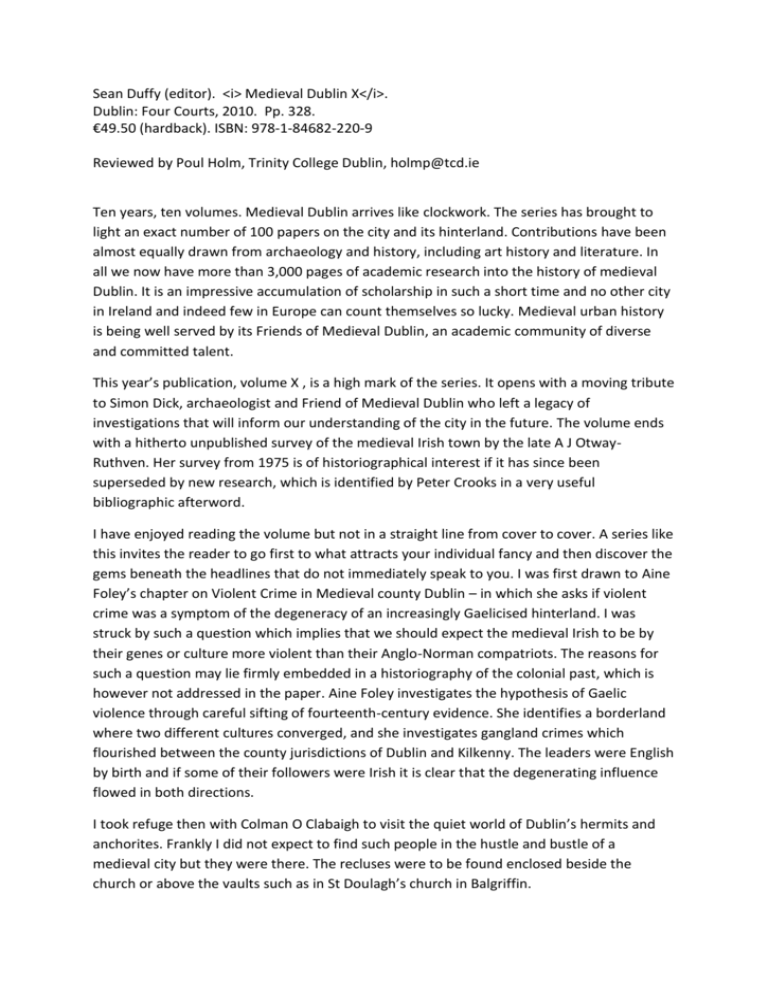
Sean Duffy (editor). <i> Medieval Dublin X</i>. Dublin: Four Courts, 2010. Pp. 328. €49.50 (hardback). ISBN: 978-1-84682-220-9 Reviewed by Poul Holm, Trinity College Dublin, holmp@tcd.ie Ten years, ten volumes. Medieval Dublin arrives like clockwork. The series has brought to light an exact number of 100 papers on the city and its hinterland. Contributions have been almost equally drawn from archaeology and history, including art history and literature. In all we now have more than 3,000 pages of academic research into the history of medieval Dublin. It is an impressive accumulation of scholarship in such a short time and no other city in Ireland and indeed few in Europe can count themselves so lucky. Medieval urban history is being well served by its Friends of Medieval Dublin, an academic community of diverse and committed talent. This year’s publication, volume X , is a high mark of the series. It opens with a moving tribute to Simon Dick, archaeologist and Friend of Medieval Dublin who left a legacy of investigations that will inform our understanding of the city in the future. The volume ends with a hitherto unpublished survey of the medieval Irish town by the late A J OtwayRuthven. Her survey from 1975 is of historiographical interest if it has since been superseded by new research, which is identified by Peter Crooks in a very useful bibliographic afterword. I have enjoyed reading the volume but not in a straight line from cover to cover. A series like this invites the reader to go first to what attracts your individual fancy and then discover the gems beneath the headlines that do not immediately speak to you. I was first drawn to Aine Foley’s chapter on Violent Crime in Medieval county Dublin – in which she asks if violent crime was a symptom of the degeneracy of an increasingly Gaelicised hinterland. I was struck by such a question which implies that we should expect the medieval Irish to be by their genes or culture more violent than their Anglo-Norman compatriots. The reasons for such a question may lie firmly embedded in a historiography of the colonial past, which is however not addressed in the paper. Aine Foley investigates the hypothesis of Gaelic violence through careful sifting of fourteenth-century evidence. She identifies a borderland where two different cultures converged, and she investigates gangland crimes which flourished between the county jurisdictions of Dublin and Kilkenny. The leaders were English by birth and if some of their followers were Irish it is clear that the degenerating influence flowed in both directions. I took refuge then with Colman O Clabaigh to visit the quiet world of Dublin’s hermits and anchorites. Frankly I did not expect to find such people in the hustle and bustle of a medieval city but they were there. The recluses were to be found enclosed beside the church or above the vaults such as in St Doulagh’s church in Balgriffin. Claire Crowley challenged me to think about the curvilinear plans of Clondalkin and other ecclesiastic sites. She makes a strong case for looking for the Roman origin of the ideas behind the circular plan-forms of early Irish church sites which have striking parallels in Wales and France and would seem to have a common Roman origin in the idea of designating the sanctuary of the place. My Danish ancestors certainly did not respect such demarcations of sanctuary, but rather found them attractive places to seek booty. Claire Downham provides a very useful survey of their ship-camps throughout Ireland in the ninth century and argues that they were the focus of intensive cross-cultural influences between the Irish and the Norse. No talk here of the degenerating influence of the Norse marauders although Claire Downham clearly identifies them as merchant-pirates. I don’t want to belabour the interpretation of gangland crime but it is striking that while one historiography sees violence as a degenerating influence, another historical tradition is more ready to accept violence as part of a beneficial cultural encounter. Edel Breathnach investigates the role of Norse Dublin in tenth- and eleventh century Leinster dynastic poetry. Very wisely the court poets of Leinster treated the Norse neighbours and ultimately subjects with a good deal of cautious circumspection. Most poets were happy just to ignore them because you never knew when a political compromise might turn these deadly foes into useful allies and then you would not want to have been the one mocking the Norse. Indeed some Irish poets might even find these Norse kings appreciative of their lyrics such as Cinaed ua hArtacain who went away with a horse as a reward for his song to king Olaf Cuaran. Clearly the sages and poets knew how to navigate the murky waters of cross-cultural exchanges. Similarly adept were the Irish of late-medieval Dublin. Sparky Booker returns to the question of Irishness as an indication of degeneration and shows that far from being a city cleansed of the Irish, late-medieval Dublin had a thriving population of Irish who married, managed to uphold some of their customs and were admitted to the hospitals of that bastion of English power. Clearly we need to dispense with simplistic notions of culture divides. However, in one case the evidence runs counter to interpretations of the blending of cultures. In Viking times not all Norsemen were appreciative of Irish culture and Christianity. Stephen Harrison makes a strong case for redating the Viking grave in Bride Street to early tenth century and seeing the weapon-heavy burial as a symbol of heathen defiance of nearby Christian burials. No volume of Medieval Dublin without a feast of new archaeological discoveries. This volume reports on discoveries in Church Street and Hammond Lane by Sinead Phelan, by Giles Dawkes on Church Street, and by Alan Hayden on Augustine Street. It is not least thanks to meticulous reports such as these that our knowledge of medieval Dublin not only improves but keeps surprising us. Based on the abundance of new evidence which has come to light in recent years, Linzi Simpson challenges future research by raising no less than 33 questions to our understanding of ninth-century Dublin. She does that with a forensic mind that step by step makes its impact on the reader and leaves you with a sense that the mud and clay of Dublin has so much more to reveal in coming years. Dr Simpson makes it abundantly clear that the simplistic idea about a relatively small settlement which was driven to the sea by 902 is anything but correct although it almost universally accepted by previous scholarship. The archaeology indicates a settlement of thousands of warriors and by implication thousands of women, children and workers of all sorts – and while the elite may have been expulsed in 902 the evidence is clear that not all followed them on their flight. Prof Sean Duffy is the key force behind the lively Medieval Dublin conferences and their publication. It requires unusual stamina to keep such a series going without interruption and compromise. The series has the financial backing of the Dublin City Council and the Four Courts Press maintain an excellent publishing standard. It is sad of course that the demise of the Celtic Tiger will mean fewer archaeological discoveries in the years to come. On the other hand, the last 10-15 years have revealed so much that the archaeologists will need to absorb and interpret that I am sure we shall see many new revelations in coming volumes of Medieval Dublin.
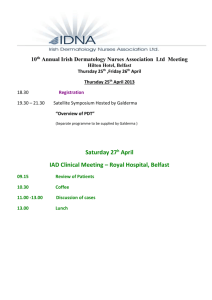
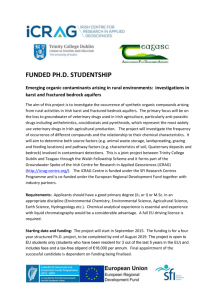
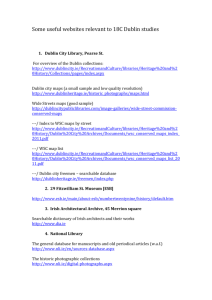
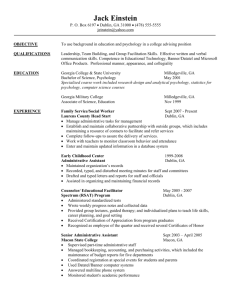
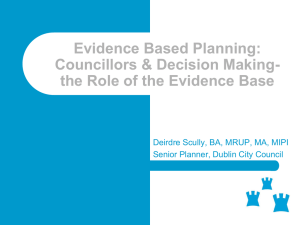
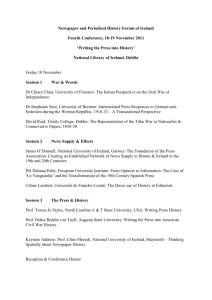
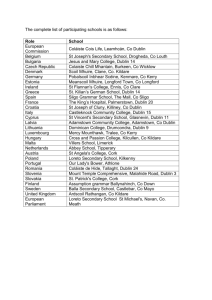
![South east presentation resources [pdf, 7.8MB]](http://s2.studylib.net/store/data/005225551_1-572ef1fc8a3b867845768d2e9683ea31-300x300.png)
